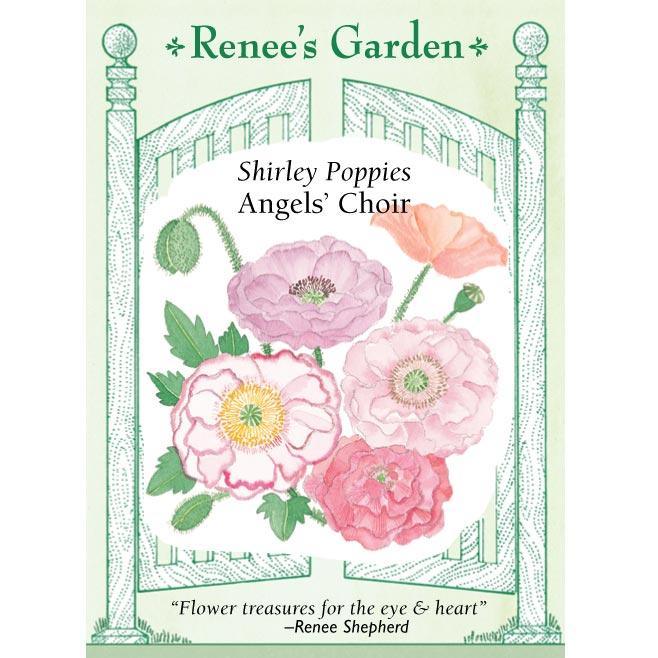Item Number: SWF5321
Shirley Poppy Angel's Choir Flower Seeds
Award Winning Watercolor Combination
Poppy (Shirley) - Angel's Choir Papaver rhoeas
Annual - his award-winning combination of silken-petaled, double poppies features shimmering watercolor shades including cream, apricot, peach, coral, lavender, pink and bi-colors and picotees. It took breeders years of selection to develop these absolutely magical forms and lustrous soft colors. Angel's Choir poppies are exquisite in the garden as the blossoms sway gracefully on nodding 3' tall stems above frothy gray-green foliage. These easy-to-grow and irresistible flower are the perfect way to welcome the joys of spring.
Soil & Water:Sow seeds directly into a finely textured seedbed in full sun as early in spring as ground can be worked. Weed and water young seedlings carefully. Mature plants can handle dry conditions but appreciate regular water in hot summer locations. Poppies make good cut flowers if brought indoors just as buds begin to open. Prolong bloom by picking off spent flowers to keep them from setting seed.
Planting & Growing: Plant as early as possible in spring, as poppies can handle frost and bloom best and longest when plants get a good start in cool weather. In mild winter climates, poppies can also be sown in fall. To help space the fine seeds, mix with dry sand before sowing. Scatter seeds thinly and cover lightly with fine soil. Keep seedbed moist as seedlings emerge over 7 - 14 days. Thin early if seedlings are crowded; final spacing should be 6 - 8" apart.
Soil Temperature: above 50°FPlanting Depth: barely cover
Germination: 7-21 Days
Height At Maturity: 2-3 feet
Sun/Shade: Full Sun
Spacing After Thinning: 6-8"
Approx Seeds per Pack: Approx. 2000 Seeds
Check Your Zone Compatibility:
Compatible with your zone.
Growing Zone for

Our Guarantee To You
Since 1976, we've served our customers at every stage of growing. Please contact us at any time. We are happy to support and assist you.
Shipping Information
Shipping Information
Shipping Weight: 0.01 lb
Dimensions: 4.5"L x 3.125"W x 0.1"H
Features
Features
- Attracts Bees/Butterflies
- Does Not Require Support
- Good Cut Flower
- Open-Pollinated
- Requires Summer Water
- Useful for Ornamental
Characteristics
Characteristics
Planting & Care
Planting & Care
Soil & Water:Sow seeds directly into a finely textured seedbed in full sun as early in spring as ground can be worked. Weed and water young seedlings carefully. Mature plants can handle dry conditions but appreciate regular water in hot summer locations. Poppies make good cut flowers if brought indoors just as buds begin to open. Prolong bloom by picking off spent flowers to keep them from setting seed.
Planting & Growing: Plant as early as possible in spring, as poppies can handle frost and bloom best and longest when plants get a good start in cool weather. In mild winter climates, poppies can also be sown in fall. To help space the fine seeds, mix with dry sand before sowing. Scatter seeds thinly and cover lightly with fine soil. Keep seedbed moist as seedlings emerge over 7 - 14 days. Thin early if seedlings are crowded; final spacing should be 6 - 8" apart.
Useful Information
Useful Information
Guarantee
Guarantee
Share



Sowed in very early spring (basically late winter sowing), then transplanted to a raised bed that doesn’t get sun all day (zone 7). The colors and ruffled petals have been the prettiest poppy I’ve ever seen! I will try fall and winter sowing with this one. I plan on sowing as many of these seeds as I can get. Will definitely be buying more!
My wife is waiting for spring to plant them. She loves all kinds of puppies, and we never knew there were so many different kinds.






